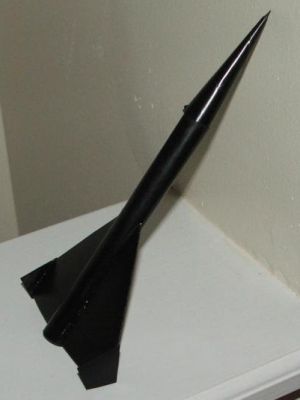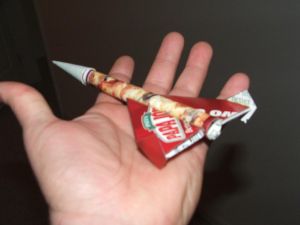Scratch Fishhead Rocketry - Phantom Cruiser Original Design / Scratch Built
Scratch - Fishhead Rocketry - Phantom Cruiser {Scratch}
Contributed by Bill Eichelberger
| Manufacturer: | Scratch |

Brief:
I actually built a larger version of this as my first scratchbuild back in 1977
using cardstock for the fins, so when I needed a paper rocket for the EMRR
Challenge, this design naturally came to mind. Heavily influenced by the Estes
Condor which was my favorite rocket back in 1977, the original Phantom Cruiser
met its demise against the side of a local church, but it was always
entertaining rocket.
Construction:
Parts list:
- Reasonably heavy cardstock is needed for the build (I used a Papa John's Pizza mailer).
- Kevlar®
The most difficult part of this project was rolling the tube and keeping it looking like a tube. I used a Papa John's Pizza mailer as a donor for the parts and wrapped it as tightly as possible around a 13mm casing to get the correct shape. After taping it in place with masking tape in the middle of the "tube", I began gluing it together from the ends with LocTite Gel CA. By the time I reached the masking tape I was easily able to remove the tape and finish the job. I made an engine block using another piece of the same mailer, rolled thicker, but just enough smaller to fit into the body tube. I tied the Kevlar® to the ring and coated the knot with wood glue, then I placed a dab of glue onto a piece of scrap balsa and spread it around inside the body tube. The engine block was then slid into place using an expended 13mm motor casing to judge the depth. I had an anxious moment when the motor stuck, but some quick work with my teeth kept it from being fatal. Barely.
The two fins/wings were cut from the same pizza mailer, except that I doubled them over and at the leading edge and added flanges at the root edge to more easily allow them to attach to the body tube. They were attached with gel CA, then filleted with wood glue. The vertical stabilizers were cut from scraps from the pizza mailer, then mounted at the ends of the wing tips with wood glue.
 The nose
cone was made by wrapping a piece of paper into a cone shape, then wrapping it
with cellophane tape to allow it to keep its shape. This left a small pinhole
in the very tip of the cone, which I sealed with a drop of wood glue. When the
glue had dried, I slid the completed cone over the body tube to get an idea
where to cut the cone off for best fit with the body tube. I marked a spot that
appeared to be just a bit longer than a perfect fit and cut the tube there,
then sanded it for a better fit. I then inserted the knotted Kevlar®
shock cord into the cone and glued it in place with a line of wood glue. When
that had dried completely, I filled the rest of the cone with wood glue. This
allowed me to hopefully take care of nose weight and the recovery anchor at the
same time. The final step in the construction process was making a plug that
attached the nose cone into the body tube. I managed this with another piece of
the pizza mailer, tightly rolled so that it slid easily into the body tube, and
secured with a heavy dollop of wood glue.
The nose
cone was made by wrapping a piece of paper into a cone shape, then wrapping it
with cellophane tape to allow it to keep its shape. This left a small pinhole
in the very tip of the cone, which I sealed with a drop of wood glue. When the
glue had dried, I slid the completed cone over the body tube to get an idea
where to cut the cone off for best fit with the body tube. I marked a spot that
appeared to be just a bit longer than a perfect fit and cut the tube there,
then sanded it for a better fit. I then inserted the knotted Kevlar®
shock cord into the cone and glued it in place with a line of wood glue. When
that had dried completely, I filled the rest of the cone with wood glue. This
allowed me to hopefully take care of nose weight and the recovery anchor at the
same time. The final step in the construction process was making a plug that
attached the nose cone into the body tube. I managed this with another piece of
the pizza mailer, tightly rolled so that it slid easily into the body tube, and
secured with a heavy dollop of wood glue.
Finishing:
I sprayed the entire model gloss black, just like the original.
Flight:
This will be quick. I only wound up with one flight on this rocket due to the
extra kick that Estes sees fit to pack into their ejection charges these days.
The flight itself was great, arrow straight and quite a bit higher than I
expected.
Recovery:
The problem came at ejection. When the ejection charge fired, I saw something
fly off at a high rate of speed, but I thought it was the expended engine. When
I got to the landing site, I found the engine sticking halfway out the back,
but no nose cone. The Kevlar®
had been blown through like it wasn't even there. I searched the field for the
cone, but I hadn't bothered to track it because I thought it was the engine. I
came up empty.
Summary:
PROs: This was a new experience for me. Flight was great and very stable.
CONs: Another rocket killed or maimed by an Estes ejection charge. Will it never end?
Sponsored Ads
 |
 |











